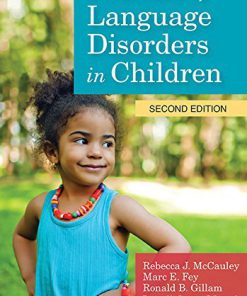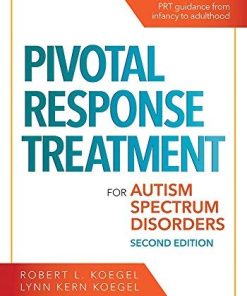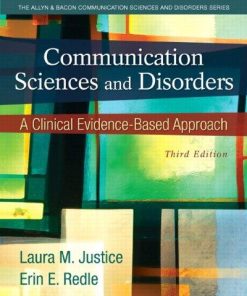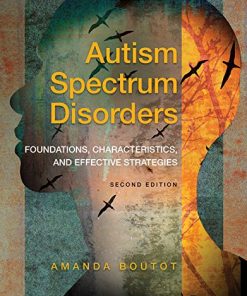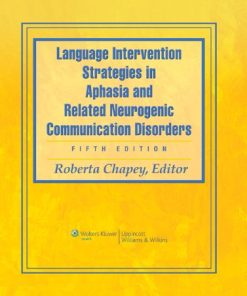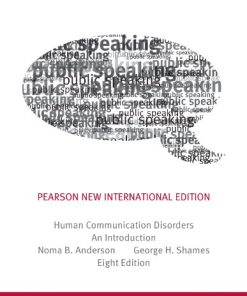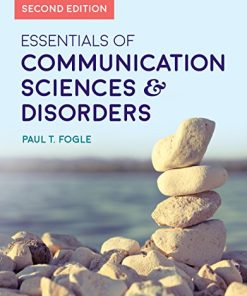(Ebook PDF) Aphasia and Related Neurogenic Communication Disorders 2nd Edition by Ilias Papathanasiou 1284117499 9781284117493 full chapters
$50.00 Original price was: $50.00.$25.00Current price is: $25.00.
Aphasia and Related Neurogenic Communication Disorders 2nd Edition, (Ebook PDF) – Digital Instant Dowload.
Aphasia and Related Neurogenic Communication Disorders 2nd Edition by Ilias Papathanasiou – Ebook PDF Instand Download/DeliveryISBN: 1284117499, 9781284117493
Full dowload Aphasia and Related Neurogenic Communication Disorders 2nd Edition after payment
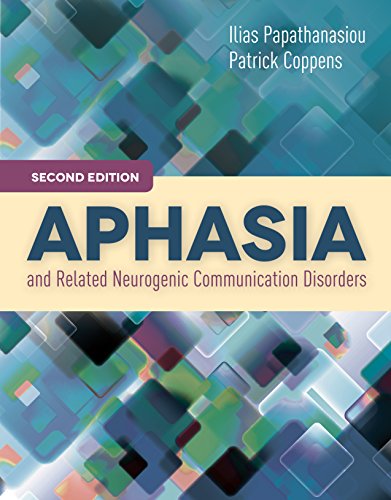
Product details:
ISBN-10 : 1284117499
ISBN-13 : 9781284117493
Author: Ilias Papathanasiou
Aphasia and Related Neurogenic Communication Disorders, Second Edition reviews the definition, terminology, classification, symptoms, and neurology of aphasia, including the theories of plasticity and recovery. Best practices of aphasia assessment and intervention are presented including neuropsychological models and formal and informal testing procedures to maximize correct clinical rehabilitative decisions. Theoretical bases for rehabilitation, guidelines for organization and delivery of evidence-based therapy, as well as augmentative and alternative communication therapy, and computer-based treatments are also presented.
Aphasia and Related Neurogenic Communication Disorders 2nd Table of contents:
Section I Aphasia
Chapter 1 Aphasia and Related Neurogenic Communication Disorders: Basic Concepts, Management, and Efficacy
Introduction
What is Aphasia?
Population and Public Health Approaches in Aphasia
Care for People with Aphasia
What is Aphasia Therapy?
What is Evidence-Based Practice in Aphasia Therapy?
Does Aphasia Therapy Work?
References
Appendix 1A Aphasia United “Top 10” International Best Practice Recommendations for Aphasia
Chapter 2 Significant Landmarks in the History of Aphasia and Its Therapy
Introduction
Aphasia in the Ancient Past
The Middle Ages
The Renaissance to the 17th Century
The 18th Century Enlightenment: Reason and Nature
The 19th Century and the Birth of a Science of Aphasiology
The Growth of Linguistic Aphasiology in the 19th and 20th Centuries
Aphasiology in the 20th Century
The Treatment of Aphasia in the Later 20th Century
References
Chapter 3 Elements of Neurology Essential for Understanding the Aphasias
Introduction
Elements of the Nervous System
A More Detailed View of the Cerebral Cortex
Methods for the Study of the Nervous System and the Brain
Elements of Clinical Neurology
Cerebral Representation of Language
Types of Aphasia, Typical Lesion Locations, and Typical Signs and Symptoms
Notes
Acknowledgments
References
Chapter 4 Plasticity and Recovery in Aphasia
Introduction
The Concepts of Plasticity and Recovery
Prognostic Factors of Recovery
Biochemical and Physiologic Mechanisms of Recovery
Structural Mechanisms of Recovery
Behavioral Mechanisms of Recovery
Language Recovery in The Brain
The Link Between Plasticity, Behavior, and Therapy
Reconceptualizing Aphasia and Aphasia Therapy
Future Directions
Notes
References
Chapter 5 Formal and Informal Assessment of Aphasia
Introduction
Formal Assessment: Purposes
Formal Assessment: Test Constructs and Procedures
Informal Assessment: Logic, Purposes, and Procedures
Assessing the Person with Aphasia
Ongoing Data Collection
Assessment Procedures: Some Additional Dos and Don’ts
Future Directions
Case Illustration 5.1
References
Chapter 6 Therapy Approaches to Aphasia
Introduction
What is Therapy?
Who is the Target of Therapy?
When?
Why?
How?
Conclusions and Future Directions
Case Illustration 6.1
References
Chapter 7 Extralinguistic Cognitive Consideration in Aphasia Management
Introduction
Cognitive Domains and Constructs
Extralinguistic Cognitive Impairments in Aphasia
Assessment
Treatment
Future Directions
Case Illustration 7.1
References
Chapter 8 Disorders of Auditory Comprehension
Introduction
Models of Normal Auditory Processing
Disorders of Auditory Comprehension
Assessment of Auditory Comprehension
Intervention Approaches
Future Directions
Case Illustration 8.1
Note
References
Chapter 9 Disorders of Word Production
Introduction
Models of Word Production: Theoretical and Empirical Foundations
Application of Cognitive/Psycholinguistic Models of Word Production to the Diagnosis Of Word Production Disorders In Aphasia
Treatment of Word Retrieval Disorders
Future Directions
Case Illustration 9.1
Case Illustration 9.2
Acknowledgments
References
Chapter 10 The Acquired Disorders of Reading
Introduction
Dual-Route Models
Connectionist Models
Acquired Alexia
Assessment
Intervention
Future Directions
Case Illustration 10.1
References
Chapter 11 Written Language and Its Impairments
Introduction
What is Written Language?
Classification of Written Language Disorders and Their Neuroanatomic Substrates
Assessment of Writing Disorders
Intervention Approaches to Writing Disorders
Conclusions and Future Directions
Case Illustration 11.1
References
Chapter 12 Disorders of Sentence Processing in Aphasia
Introduction
Agrammatism and Paragrammatism
Sentence Complexity
A Sentence-Processing Model
Structural Impairments
Case Illustration 12.1: Therapy at the Level of the Event
Case Illustration 12.2: Mapping Therapy With A.E.R
Case Illustration 12.3: TUF Treatment Protocol for Training Object wh- Questions
Verb Impairments
Impairments with Grammatical Morphology
Competence Versus Performance
Agrammatism and Conversation
Conclusions and Future Directions
Notes
References
Chapter 13 Approaches to Assessment and Treatment of Everyday Talk in Aphasia
Introduction
Rationale for Discourse, Conversation Analytic, and Narrative Approaches
Difficulties with Everyday Talk: Symptoms of Discourse Breakdown
Assessment Issues
Practical Analysis Issues
Intervention
Conclusions and Future Directions
Case Illustration 13.1
References
Chapter 14 Quality-of-Life Approach to Aphasia
Introduction
Quality of Life and Related Concepts
Assessing QOL and HR-QOL
Clinical Applications
Conclusions and Future Directions
Case Illustration 14.1: Exploring Broader Outcomes
Case Illustration 14.2: Using QOL Measures in Therapy Planning
Notes
References
Chapter 15 Living With Aphasia: A Client-Centered Approach
Introduction
A Focus on Client-Centeredness
The Social and Emotional Impact of Aphasia
Intervention Approaches That Address the Psychosocial Dimension
Skills and Strategies for the Client-Centered Aphasia Therapist
Conclusions and Future Directions
Case Illustration 15.1
References
Chapter 16 Aphasia in Multilingual Populations
Introduction
Experiential Factors in Aphasia Services for Bilingual Speakers
Aphasia in Bilingual Speakers
Aphasia Rehabilitation with the Bilingual Individual
Future Directions
Case Illustration 16.1
References
Section II Related Communication Disorders
Chapter 17 Nature and Assessment of Right Hemisphere Disorders
Introduction
Theoretical Accounts of Cognitive–Communication Deficits in Right Hemisphere Disorders
Symptomatology of Cognitive–Communication Disorders In Right Hemisphere Disorder
Assessment of Patients with Right Hemisphere Disorder
Future Directions
Case Illustration 17.1
References
Appendix 17A Sample Case History Supplement Form
Appendix 17B A Performance Inventory for Everyday Environments and Tasks
Chapter 18 Treatment of Right Hemisphere Disorders
Introduction
Focusing Treatment
Generalization of Treatment Gains
Evidence-Based Practice
Treatment for Coarse Coding Deficit and Related Difficulties
Treatment for Suppression Deficit and Related Difficulties
Treatment Considerations Related to the Cognitive Resource Hypothesis
Treatment for Social Cognition Deficit
Treatment of Prosody
Treatment of Discourse And Pragmatics
Treatment of Reading And Writing
Treatment of Cognition
Treatment Targeting Other Obstacles To Goal Attainment
Future Directions
Case Illustration 18.1
References
Chapter 19 Traumatic Brain Injury in Adults
Introduction
Neurology and Neuropathology of Traumatic Brain Injury
Continuum of Rehabilitation in Traumatic Brain Injury
Conceptualizing Cognitive Rehabilitation
WHO International Classification Framework: Assessment and Treatment of Cognitive and Communication Disorders
Neurobehavioral Assessment in Traumatic Brain Injury
Principles of Cognitive Rehabilitation
Instructional Approaches in Cognitive Rehabilitation
Reviewing the Evidence for Cognitive Rehabilitation
Conclusions and Future Directions
Case Illustration 19.1
Notes
References
Appendix 19A Rancho Los Amigos Scale
Appendix 19B Assessment Tools Based on the World Health Organization Model
Chapter 20 Dementia and Related Cognitive Disorders
Introduction
Defining the Syndrome of Dementia
Neuropathology in Alzheimer’s Disease
Defining Mild Cognitive Impairment
Effects of Alzheimer’s Disease on Cognition
Symptomatology of Communication Disorders in Alzheimer’s Disease
Role of Speech–Language Clinicians Working with Individuals Who have Dementia
Evaluation of Communication in Clients with Alzheimer’s Disease and Other Dementias
Cognitive Communication Interventions in Dementia: Challenges and Opportunities
Other Dementias
Future Directions
Case Illustration 20.1
Acknowledgment
References
Chapter 21 Acquired Apraxia of Speech
Introduction
Defining Apraxia of Speech
The Nature of Apraxia of Speech
Clinical Assessment and Differential Diagnosis
Speech Output Models and Apraxia of Speech
Lesion Sites Associated with Apraxia of Speech
Treatment
Future Directions
Case Illustration 21.1
References
Chapter 22 Management of Dysarthria
Introduction
Models of Speech Production and Speech Motor Control
Life-Span Perspectives on Dysarthria
Issues of Dysarthria Classification
Assessment of Dysarthria
Interventions for Dysarthria
Future Directions
People also search for Aphasia and Related Neurogenic Communication Disorders 2nd:
what are neurogenic communication disorders
neurogenic communication disorders examples
neurogenic aphasia
neurogenic communication disorders asha
what neurological disorders cause aphasia
You may also like…
Medicine & Health Science
Pivotal Response Treatment for Autism Spectrum Disorders 2nd Edition, (Ebook PDF)
Uncategorized
Uncategorized
Uncategorized
Uncategorized
Diagnosis and Treatment of Mental Disorders Across the Lifespan 2nd Edition, (Ebook PDF)




